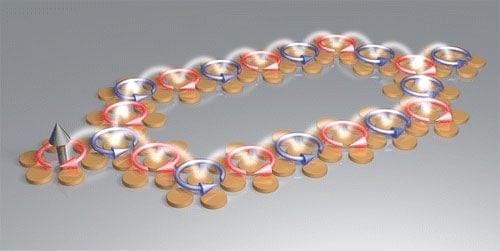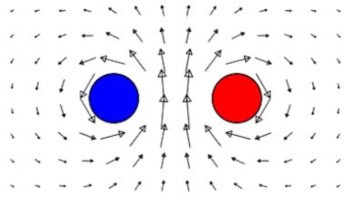
Researchers in the US have made waveguides for magnetic plasmons from “fused” organic molecules. The structures allow magnetic plasmons to be transmitted and focused in ways not possible with conventional electron plasmons. This could lead to a new family of nanoscale photonic devices, say the scientists.
Normally, light cannot be focused to a spot smaller than half its wavelength – a distance of about 300 nm for visible light. However, in recent years scientists have succeeded in focusing light down to nanometre distances by coupling it to plasmons that occur on the surfaces of metal nanostructures. These surface plasmons are collective excitations of the metal’s conduction electrons and they couple with light to create surface plasmon polaritons (SPPs), which behave like light but have much shorter wavelengths. SPPs are at the heart of an emerging technology called “nanoplasmonics”, which concentrates on using metallic nanostructures to develop tiny optoelectronics devices.
In this latest study, Naomi Halas and colleagues at Rice University in Houston have focused on magnetic plasmons, which are formed when electrons oscillate in a circular fashion to create a magnetic moment. This is different to conventional plasmons, which involve the back-and-forth oscillation of electrons. The researchers found that magnetic plasmons can propagate over distances of several micrometres along a conjugated chain of artificial aromatic molecules called heptamers. This is much farther than conventional electron plasmons, which can only travel a few hundred nanometres along linear chains of metallic nanoparticles.
Unique ring currents
The chain made at Rice comprises “fused” heptamers carefully arranged in such a way that they resemble the organic aromatic molecules chrysene and triphenylene. The heptamers are composed of ring-like components and support currents that circulate around the structures when illuminated with light from an infrared laser operating at 1500 nm.
In organic chemistry, rings are said to be fused if they share two or more atoms, explains team member Na Liu. “In our work, the fused heptamers share two gold nanoparticles that act as a mutual link for efficient current exchange between the two neighbouring heptamers,” she says.
Network building blocks
Halas and team showed that the fused heptamers can be used as building blocks for networks of magnetic plasmonic waveguides. The researchers succeeded in making a steering device that can direct the plasmons around bends with large angles and a Y-splitter than can transport plasmons along two separate optical paths. The Y-splitter can also act as an interferometric device to switch plasmon propagation and on and off, says Halas.
“We also made a Mach–Zehnder interferometer comprising two consecutive Y-splitters that can split and combine propagating plasmons,” adds Liu.
According to the researchers, the plasmon-based subwavelength waveguides could find applications in areas including low-loss energy transport, data storage and near-field microscopy.
The work is described in ACS Nano.



